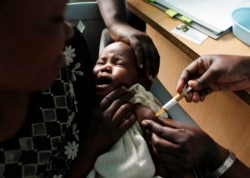ເຮືອບິນບໍ່ມີຄົນຂັບ ກຳລັງຖືກໃຊ້ເປັນອາວຸດຊະນິດໃໝ່ ໃນການຕໍ່ສູ້ຕ້ານກັບໄຂ້ມາເລເຣຍ ຫລືໄຂ້ຍຸງ ຢູ່ໃນເກາະ ແຊນຊີບາ (Zanzibar). ໂດຍສະເພາະແມ່ນ ຢູ່ໃນບ້ານ ເຈຈູ (Cheju) ນັ້ນ ເຮືອບິນບໍ່ມີຄົນຂັບ ກຳລັງເອົາ ຂອງແຫລວທີ່ມີທາດຊີລິຄອນພົ່ນໃສ່ທີ່ບ່ອນທີ່ມີນ້ຳຂັງໃນໄຮ່ນາອັນກວ້າງໆ ທີ່ເປັນບ່ອນທີ່ຍຸງໄປໄຂ່ໃສ່. ມາຣີແອມາ ດີຢາໂລ (Mariama Diallo), ນັກຂ່າວຂອງວີໂອເອ ມີລາຍງານມາກ່ຽວກັບວິທີທີ່ປະເທດດັ່ງກ່າວໃຊ້ວິທີການໃໝ່ນີ້ເພື່ອສູ້ກັບພະຍາດດັ່ງກ່າວ ຊຶ່ງບົວສະຫວັນ ຈະນຳມາສະເຫນີທ່ານໃນອັນດັບຕໍ່ໄປ.
ເຮືອບິນບໍ່ມີຄົນຂັບຄືແນວນນີ້ ກຳລັງພົ່ນສານລະລາຍທີ່ມີທາດສີລິຄອນ (silicon) ໃສ່ເທິງໜ້ານ້ຳທີ່ຂັງຢູ່ ເພື່ອເຮັດໃຫ້ມັນເກີດມີຊັ້ນບາງໆ ທີ່ໃນທີ່ສຸດກໍຈະປ້ອງກັນບໍ່ໃຫ້ຍຸງສາມາດເບາະໄຂ່ອອກມາໄດ້.
ດຣ. ບາດທ໌ ໂນລສ໌ (Bart Knols) ເປັນນັກວິທະຍາສາດດ້ານແມງໄມ້ທີ່ໃຊ້ທາງການແພດ ແລະເປັນນັກຄົ້ນຄວ້ານຳພາທີມງານທີ່ເຮັດວຽກກັບໂຄງການລົບລ້າງພະຍາດມາເລເຣຍຂອງເກາະແຊນຊີບາ (Zanzibar). ທ່ານເວົ້າວ່າ ວິທີນີ້ ເຮັດໃຫ້ຈຳນວນຂອງຍຸງທີ່ນຳເອົາໄຂ້ຍຸງ ຫລືມາເລເຣຍໄປແຜ່ຜາຍຫລຸດລົງໄດ້ ຢ່າງຫລວງຫລາຍຢູ່ໃນຂົງເຂດດັ່ງກ່າວ.
ດຣ. ໂນລສ໌ (Knols), ນັກວິທະຍາສາດຕ້ານພະຍາດມາເລເຣຍກ່າວວ່າ:
"ການເຮັດແນວນີ້ ຈະໃຊ້ເວລາໄປປະມານ 3 ອາທິດ, ບາງເທື່ອອາດຮອດ 4 ອາທິດ, ຫລັງຈາກນັ້ນສິ່ງຄວບຄຸມທາງຊີວະພາບຊຶ່ງເປັນແຜ່ນບາງໆ ກໍຈະແຕກອອກເອງ. //ຈາກນັ້ນ// ຫລັງຈາກນຶ່ງເດືອນຜ່ານໄປ ທ່ານອາດຈະເອົາແຜ່ນບາງໆນີ້ ປົກໃສ່ເທິງໜ້ານ້ຳອີກ ແລະທ່ານກໍຈະມີຄວາມສາມາດຄວບຄຸມຍຸງໄດ້ຫລາຍຂຶ້ນ."
ຖ້າຫາກປາດສະຈາກຊັ້ນແຫລວໆ ທີ່ວ່ານັ້ນແລ້ວ ໂຕດັກແດ້ຍຸງກໍຈະເຕີບໂຕກາຍໄປເປັນຍຸງໃຫຍ່ທີ່ຊອກຫາກິນເລືອດເພື່ອເປັນອາຫານໄດ້. ເມື່ອຍຸງເຫລົ່ານັ້ນ ກັດຄົນທີ່ຕິດເຊື້ອພະຍາດມາເລເຣຍ ພວກມັນກໍຈະກາຍເປັນຕົວນຳເຊື້ອພະຍາດດັ່ງກ່າວ ແລະກໍຈະເຮັດໃຫ້ມີວົງວຽນແຫ່ງການແຜ່ຜາຍສືບຕໍ່ໄປຢ່າງເປັນອັນຕະລາຍ.
ຢູ່ຕາມແຄມຝັ່ງມະຫາສະໝຸດອິນເດຍຂອງທະວີບອາຟຣິກາຕາເວັນອອກ, ເກາະແຊນຊີບາ ແລະແຜ່ນດິນໃຫຍ່ແທນຊາເນຍ ໄດ້ທຳການຕໍ່ສູ້ຕ້ານກັບພະຍາດມາເລເຣຍ ມາເປັນເວລາດົນນານແລ້ວ. ການໃຊ້ເຮືອບິນບໍ່ມີຄົນຂັບເປັນວິທີທີ່ດີທີ່ສຸດ ເພື່ອແກ້ໄຂບັນຫາດັ່ງກ່າວ, ອີງຕາມຄຳເວົ້າຂອງທ່ານ ອັບດູລາ ອາລີ (Abdula Ally) ຈາກໂຄງການລົບລ້າງພະຍາດມາເລເຣຍຂອງແຊນຊີບາ (Zanzibar).
ທ່ານກ່າວດັ່ງນີ້: “ໂດຍໃຊ້ການຢັບຢັ້ງພະຍາດປະເພດທີ່ໃຊ້ມືເຮັດເອົາ ແລ້ວທ່ານກໍຈະບໍ່ສາມາດ ທີ່ຈະປົກຄຸມເອົາເນື້ອທີ່ ທີ່ກວ້າງກວ່ານັ້ນໄດ້ ແຕ່ວ່າວິທີນີ້ຈະເຮັດໃຫ້ມີຄວາມ ແຕກຕ່າງກັນ.”
ບັນດາເຈົ້າໜ້າທີ່ເວົ້າວ່າ ການພົ່ນທາດແຫລວໂດຍໃຊ້ເຮືອບິນບໍ່ມີຄົນຂັບ ເປັນວິທີການທີ່ຂ້ອນຂ້າງມີຄ່າໃຊ້ຈ່າຍຖືກ ເພື່ອສະກັດກັ້ນບໍ່ໃຫ້ຍຸງແຜ່ພັນໄດ້.
ທ່ານ ກິດໂດ ແວລເທີ, Guido Welter, ທີ່ເຮັດວຽກຢູ່ໃນໂຄງການເຮືອບິນບໍ່ມີຄົນຂັບສຳລັບພະຍາດມາເລເຣຍເວົ້າວ່າ:
“ເຮືອບິນບໍ່ມີຄົນຂັບສາມາດບິນເຫວີ່ນໃນລະດັບຄວາມໄວທີ່ພວກເຮົາດັດປັບໄດ້, ໃນ 1 ເຮັກຕາ ໂດຍການພົ່ນທາດແຫລວ 10 ລິດ ຈະໃຊ້ເວລາຢູ່ 3 ນາທີ; ພວກເຮົາຄິດໄລ່ວ່າພາຍໃນນຶ່ງຊົ່ວໂມງ ພວກເຮົາສາມາດພົ່ນໄດ້ 8 ເຮັກຕາ.”
ອັນນັ້ນເທົ່າກັນກັບຂະໜາດຂອງເດີ່ນຫລິ້ນກິລາຣັກບີ 8 ເດີ່ນ. ທ່ານ ແອດດູອາໂຣ ໂຣດິເກສ (Eduardo Rodriguez), ຜູ້ຈັດການຝ່າຍຜະລິດຕະພັນສຳລັບເຮືອບິນບໍ່ມີຄົນຂັບຂອງບໍລິສັດດີເຈໄອ ອາແກຣັສ (DJI Agras), ເວົ້າວ່າ ໃນຂະນະທີ່ເຮືອບິນບໍ່ມີຄົນຂັບສາມາດທີ່ຈະປະຕິບັດງານໄດ້ໂດຍແບບໃຊ້ມືບັງຄັບເອົາ ມັນກໍຍັງສາມາດເຮັດວຽກແບບຄວບຄຸມໂຕເອງໄດ້ຢ່າງອັດຕະໂນມັດ ເຊັ່ນກັນ.
ທ່ານ ໂຣດິເກສ (Rodriguez), ກ່າວດັ່ງນີ້:
"ພວກເຮົາຍັງສາມາດບິນແບບໃຫ້ມັນບິນຢ່າງອັດຕະໂນມັດໄດ້ຢ່າງເຕັມສ່ວນອີກດ້ວຍ ຊຶ່ງນັກບິນທີ່ຮູ້ຈັກການປະສານງານທາງ GPS, ຮູ້ຈັກຂົງເຂດທີ່ຕ້ອງການໃຫ້ພົ່ນ ແມ່ນສາມາດເລືອກເອົາຂົງເຂດນັ້ນ, ສາມາດເອົາຂໍ້ມູນກ່ຽວກັບວົງລັດສະໝີຂອງການບິນ ແລະຂອງການພົ່ນສອງສາມອັນເຂົ້າໃສ່ໃນນັ້ນ ແລະກໍພຽງແຕ່ກົດ 2 ປຸ່ມເທົ່ານັ້ນລະກໍແລ້ວ.”
ອີງຕາມອົງການອະນາໄມໂລກ, ເຮືອບິນອາຄວາເທັນ ເອເອັມເອັຟ (Aquatain AMF), ຊຶ່ງເປັນຜະລິດຕະພັນທີ່ຈະໃຊ້ໃນການພົ່ນທາດແຫລວທີ່ວ່ານີ້, ແມ່ນມີຄວາມປອດໄພ ແລະ ມີປະສິດທິພາບສູງເມື່ອໃຊ້ມັນໃຫ້ຖືກຕ້ອງຕາມຄຳແນະນຳທີ່ຂຽນໄວ້ ຢູ່ໃນສະຫລາກຕິດຢູ່ນັ້ນ.
ເບິ່ງວີດິໂອກ່ຽວກັບລາຍງານນີ້ເພີ້ມເປັນພາສາອັງກິດ
ອ່ານຂ່າວນີ້ເພີ້ມເປັນພາສາອັງກິດຢູ່ລຸ່ມນີ້
Drones are being used as a new weapon in the fight against Malaria on the island of Zanzibar. In the village of Cheju in particular, drones are spraying a silicone-based liquid on large stretches of stagnant water in rice paddies where malaria-carrying mosquitoes lay their eggs. VOA Correspondent Mariama Diallo reports on how the country is using the new method to combat the disease.
Drones like this are spraying a silicon solution across standing water forming a thin layer that will eventually prevent mosquito eggs from hatching.
Dr. Bart Knols is a medical entomologist and the lead researcher working with the Zanzibar Malaria Elimination Program. He says this method will significantly reduce the numbers of the malaria-carrying mosquitoes in the area.
Bart Knols, Anti-Malaria Scientist:
"This will last for around three weeks may be four weeks, then after that the biological control agent, the film will breakdown by its self. // Then // after a month you apply a new film on the water surface and you have more control of the mosquitos."
Without the gel, the larvae would have become adult mosquitoes in search of a bloodmeal. When those mosquitoes bite humans infected with malaria, they become vectors for the disease and continue the deadly transmission cycle.
Along the Indian Ocean coast of East Africa, Zanzibar and mainland Tanzania have had a long battle with malaria. Using drones is the best way to tackle the problem, says Abdula Ally from the Zanzibar Malaria Elimination Program.
Abdula Ally, Zanzibar Malaria Elimination Program:
"With manual kind of intervention then you'll not be able to cover the wider area, but this one is going to be different."
Officials say drone spraying is a relatively inexpensive way to stop the mosquitoes from reproducing.
Guido Welter is with the Drone for Malaria Project.
Guido Welter, Drone for Malaria Project:
"A drone can fly with the speed we adjust, one hectare with ten liters will be three minutes; we calculated that within one hour we can spray eight hectares."
That's equivalent to the size of eight rugby fields. The product manager for DJI Agras drones, Eduardo Rodriguez, says while the drones can operate in manual mode, they can also do the job automatically.
Eduardo Rodriguez, DJI Europe Product Manager
"We can also fly into fully autonomous fly mode where the pilot knowing the GPS coordinates, knowing the area that needs to be sprayed can select that area, can input the few flying and spraying parameters and literary press two buttons."
According to the World Health Organization, Aquatain AMF, the product being sprayed, is safe and effective when used according to the directions on the labels.






